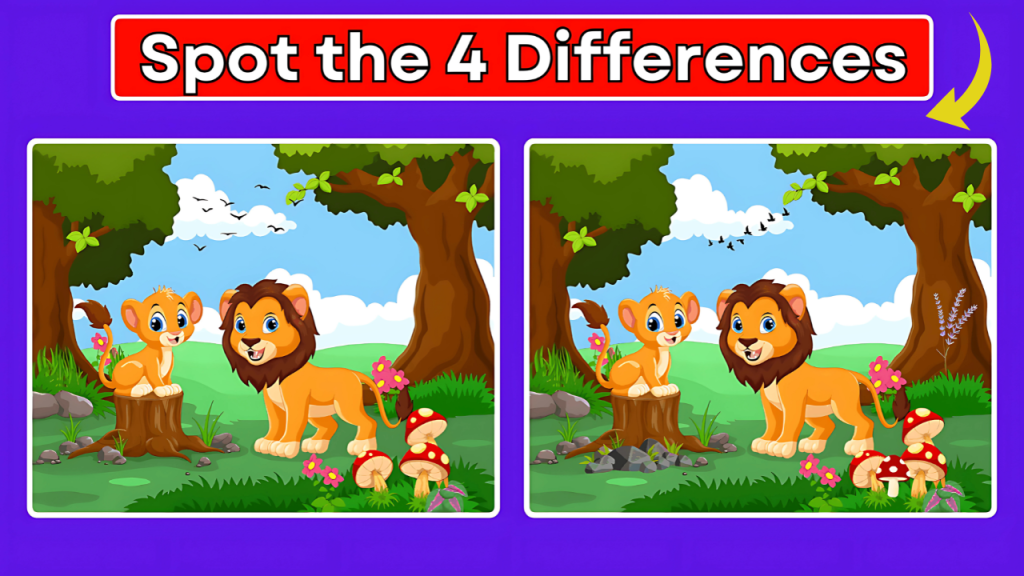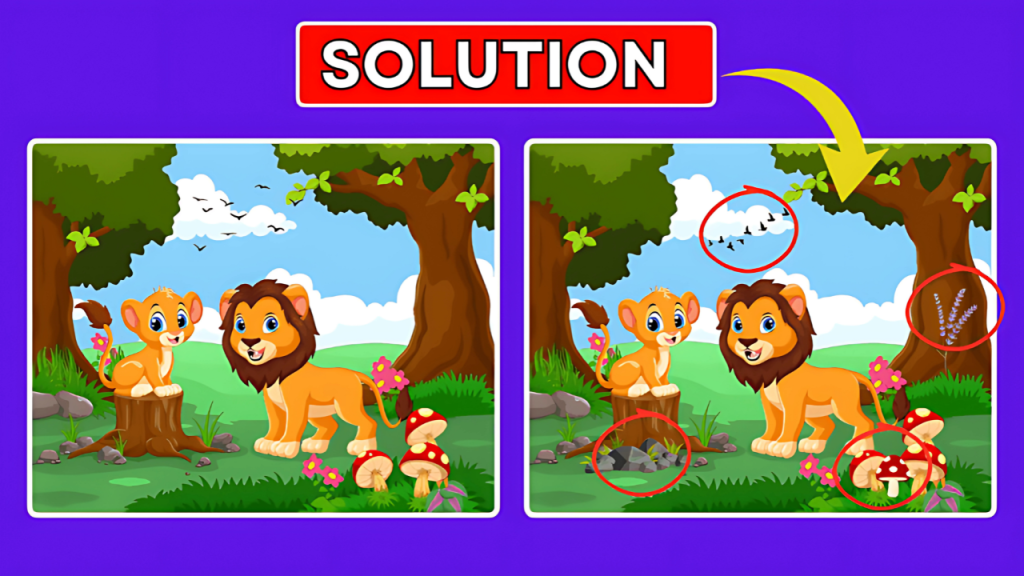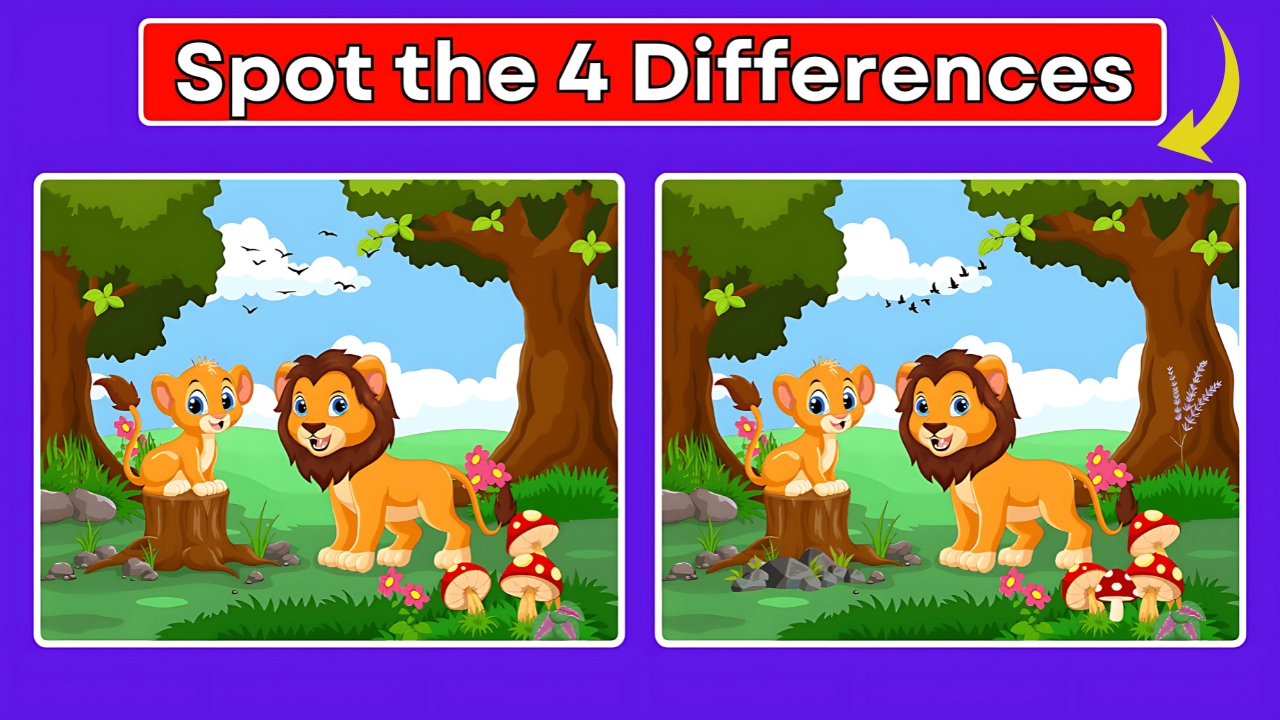Optical Illusion Have you ever felt that rush of excitement when searching for tiny changes between two nearly identical pictures? My heart still races when I’m down to the last few seconds, desperately scanning for that final elusive difference. There’s something deeply satisfying about the moment when your brain finally clicks and you spot what was hiding in plain sight all along.
Today I’m sharing one of my favorite visual puzzles featuring a majestic lion basking in golden savanna sunlight. This challenge has been driving people crazy online, with only the sharpest-eyed observers able to spot all four differences within the 10-second time limit.
Why We’re Obsessed With Spot-the-Difference Games
Remember flipping through puzzle books as a kid, determined to find every little change between two pictures? I used to spend hours on these pages, refusing to move on until I’d circled every single difference. This childhood pastime has evolved into sophisticated brain teasers that continue captivating us well into adulthood.
These seemingly simple challenges trigger something primal in our brains. Each discovered difference releases a tiny burst of dopamine – that feel-good chemical that keeps us coming back for more. It’s the same satisfaction you get from fitting the last piece of a jigsaw puzzle perfectly into place.
The time pressure adds another layer of excitement to these visual hunts. When you only have seconds to find all the differences, your brain shifts into high gear. Your eyes dart across the images with newfound purpose, and suddenly even the smallest details demand your attention.

The Lion Challenge: Testing Your Visual Skills
The particular challenge I’m sharing today features a stunning lion in its natural habitat. At first glance, the two images appear identical – the same proud big cat surveying its territory under the African sun. But hidden within these twin pictures are four carefully concealed differences that even the keenest observers struggle to find within the time limit.
What makes this puzzle especially tricky isn’t just the clock ticking down from ten seconds. The creator of this challenge knew exactly where to hide the changes to confuse your brain. They’ve placed them in spots where your eyes naturally gloss over or in areas with complex patterns that mask subtle alterations.
I’ve shown this puzzle to dozens of friends, and watching their reactions has been fascinating. Some immediately spot one or two differences but get stuck finding the rest. Others develop elaborate scanning strategies, dividing the image into sections to methodically search for discrepancies. The most impressive observers seem to take in both images at once, allowing the differences to simply “pop” into their awareness.
The Science Behind Our Visual Perception
Our eyes aren’t just passive cameras recording everything in front of us. Your visual system actively filters and interprets information, deciding what deserves your precious attention. This complex processing explains why some differences jump out immediately while others remain frustratingly hidden.
When looking at nearly identical images, your brain instinctively searches for patterns and deviations. High-contrast areas naturally draw your attention first, which is why changes to brightly colored elements or objects in the foreground are typically spotted more quickly than subtle alterations in shadowy or background areas.
Your expectations also play a crucial role in what you notice. If you’re looking at a lion image, your brain automatically focuses on the animal itself – its mane, face, and posture. Meanwhile, small changes to the background environment might completely escape your notice because you’re not actively looking for them.
Strategies for Finding Differences Faster
After watching countless people attempt this challenge, I’ve noticed that those who succeed tend to use specific strategies. Instead of randomly scanning the images, they develop a systematic approach. Some start from the top left corner and work their way across and down, ensuring no area goes unchecked. Others focus on comparing specific elements – first the lion, then the ground, then the sky.
Blinking rapidly between looking at both images sometimes helps reveal changes that remain hidden when staring too intently. Our visual system is naturally attuned to detect motion and change, so this technique leverages your brain’s built-in capabilities.
Another effective trick is to slightly unfocus your eyes or look at the images from a different angle. This changes how your visual system processes the information, sometimes making differences suddenly apparent that were previously invisible. I’ve watched people literally tilt their heads or take a step back from their screens only to immediately point out a difference they’d been missing for minutes.
Optical Illusion Answer

Benefits Beyond Entertainment
These visual puzzles aren’t just fun time-killers – they actually exercise important cognitive functions. Regularly challenging yourself with spot-the-difference activities strengthens your attention to detail, a skill that transfers to many real-world tasks from driving safely to excelling at detail-oriented work.
Parents and teachers have long recognized the developmental benefits these puzzles offer children. Kids improve their concentration, learn patience, and develop visual discrimination skills without realizing they’re engaged in educational activity. I’ve seen struggling students dramatically improve their focus after regular practice with visual puzzles.
Many professionals rely on exceptional observational skills in their daily work. Medical diagnosticians need to detect subtle abnormalities in scans, quality control inspectors must identify minute defects, and security personnel constantly scan environments for anything out of place. All these professionals can benefit from the visual training these puzzles provide.
The 4 Hidden Differences Revealed
If you’ve been staring at our lion images without success, don’t worry – you’re not alone. Even after revealing the differences to frustrated players, I often hear “How did I miss that?” The changes are cleverly disguised to challenge even the most observant eyes.
The first difference involves the background scenery – a small mushroom appears in one image but is completely absent in the other. Its earthy coloration blends perfectly with the surroundings, making it nearly invisible unless you’re specifically looking in that exact spot.
Look closely at the ground near the lion and you’ll discover the second change – an extra stone sits inconspicuously among others of similar shape and color. This addition is particularly devilish because it looks so natural that your brain automatically accepts it as part of the landscape.
The third difference requires shifting your attention to the sky, where several birds soar in one image but are missing from the other. Their tiny size against the vast blue backdrop makes them easy to overlook, especially when your focus remains fixed on the more prominent lion figure.
Finally, a delicate flower peeks through the grass in just one of the images. Its small size and position near the frame’s edge means many viewers never even glance in its direction during their frantic 10-second search.
Why Some People Excel at These Challenges
Have you ever wondered why certain friends can immediately spot differences that remain invisible to you? Several factors contribute to this seemingly superhuman ability. While good eyesight certainly helps, it’s not simply about having 20/20 vision.
Some people naturally distribute their attention more effectively across entire scenes. Instead of getting caught examining individual details, they maintain peripheral awareness that helps catch discrepancies. This ability to spread focus without losing precision is partly innate but can improve with practice.
Experience plays a huge role in success. People who regularly engage with visual puzzles develop mental shortcuts and expectations about where differences typically hide. Their brains become trained to recognize patterns of alteration that newcomers haven’t yet learned to detect.
The way we process visual information also varies between individuals. Some people are more sensitive to changes in color, while others more readily notice spatial discrepancies like slight position shifts or size changes. These personal strengths and weaknesses create unique profiles of observational ability.
Creating Your Own Visual Challenges
After showing these puzzles to friends and family for years, I eventually tried my hand at creating my own. It’s a surprisingly rewarding creative exercise that gives you appreciation for the subtle art of puzzle design. If you’d like to try making your own spot-the-difference challenges, here are some tips I’ve learned.
Start with high-quality photographs containing plenty of details. Natural scenes work particularly well because they offer numerous elements that can be subtly altered without looking obviously manipulated. I’ve found landscapes, busy street scenes, and animal images make excellent starting points.
When making changes, variety is key. Include some relatively obvious differences to give players early success, along with more challenging alterations that require careful observation. A good puzzle should be difficult enough to challenge but not so impossible that it only leads to frustration.
Digital editing tools make the process straightforward, even for beginners. Simple changes to color, size, position, or the addition/removal of small elements create effective differences. Remember that context matters enormously – a tiny change in an unexpected location proves much more difficult to spot than a larger change in an area where viewers naturally look first.
The Social Aspect of Visual Puzzles
What started as simple paper games has evolved into a thriving online community. Social media platforms regularly feature these challenges, often with engaging captions like “Only 2% can find all differences!” Such framing taps into our competitive nature, driving millions to test and share their perceptual abilities.
The comments sections of these posts reveal how these individual challenges create shared experiences. People proudly announce their success times or admit defeat and ask for hints. Others describe their emotional journey from frustration to triumph. These interactions transform solitary puzzle-solving into a communal activity.
I’ve personally witnessed how these challenges bring people together in real life too. At family gatherings, I’ve seen three generations huddled around a tablet, pointing and debating as they collectively search for differences. There’s something uniquely accessible about these puzzles – they require no special knowledge or equipment, just the willingness to pay attention.
FAQs About Spot-the-Difference Challenges
Why can some people spot differences much faster than others?
Individual differences in visual processing speed, attention distribution, and pattern recognition all contribute. Some people have naturally stronger visual discrimination abilities, while others develop these skills through regular practice.
Do spot-the-difference puzzles actually improve brain function?
Yes! Regular engagement with these puzzles enhances visual processing, attention to detail, and working memory. They create neural pathways that strengthen with practice, potentially benefiting other tasks requiring visual discrimination.
What’s the best strategy for solving these puzzles quickly?
Develop a systematic scanning pattern rather than looking randomly. Divide the image into sections and check each methodically. Pay special attention to boundaries between objects and look for breaks in patterns.
Are digital or printed spot-the-difference puzzles better for brain training?
Both formats offer similar benefits. Digital versions often track time more precisely and provide immediate feedback, while printed puzzles may reduce eye strain for extended sessions. Regular practice matters most, regardless of format.
Can children benefit from spot-the-difference activities?
Absolutely! These puzzles help develop crucial cognitive skills in children, including attention to detail, visual discrimination, and patience. They’re particularly valuable because kids enjoy them without realizing they’re educational.
How do puzzle creators decide where to hide differences?
Experienced puzzle designers understand visual psychology and deliberately place changes where eyes naturally skip or in areas with complex patterns that mask alterations. They combine obvious and subtle differences to create engaging challenges.
Why do I sometimes stare right at a difference without seeing it?
This phenomenon, called “change blindness,” occurs when your brain fills in expected details rather than processing what’s actually there. It demonstrates how much our perception depends on expectations rather than simply recording everything we see.
Does age affect spot-the-difference ability?
Visual processing speed may decline slightly with age, but experience and strategy often compensate. Many older adults excel at these puzzles due to well-developed observational skills and systematic approaches developed over years of practice.
Whether you spotted all four differences in our lion challenge or not, remember that improvement comes with practice. Keep challenging yourself with visual puzzles to sharpen your observational skills while having fun. The satisfaction of that “aha!” moment when you finally spot a well-hidden difference makes the hunt worthwhile every time.
Next time you’re scrolling through social media and spot one of these challenges, take a moment to engage your brain. You’ll be giving yourself a mini mental workout while experiencing the simple joy of visual discovery. And who knows – you might just surprise yourself with your improving perceptual abilities!
